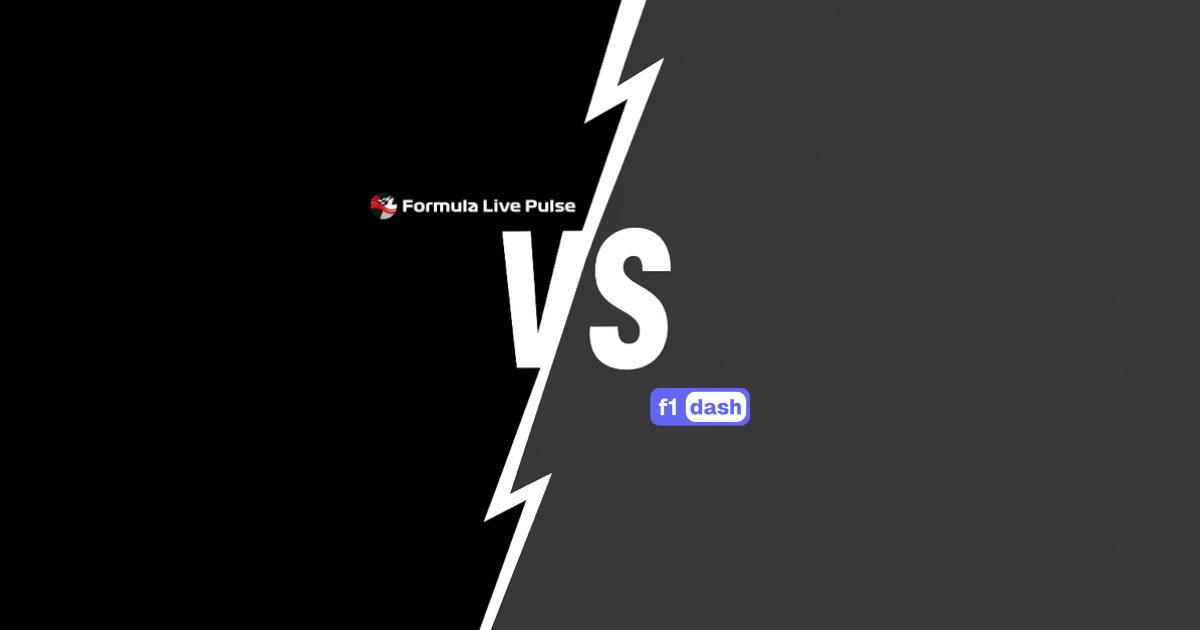
Formula Live Pulse vs F1-Dash: the ultimate F1 data dashboard comparison
For the serious Formula 1 fan, the main race broadcast is just the tip of the iceberg. It's a fantastic, curated story, but the real race---the strategic duels, the tyre-life calculations, the milliseconds won and lost through a single corner---is happening in the data. This realization has given rise to the "second-screen experience." Fans no-longer just watch; they analyze, seeking a "pit wall" experience in their own homes.
This demand has created a new market for real-time data dashboards, tools that transform a passive viewer into an active analyst. Two prominent names in this space are Formula Live Pulse and F1-Dash.
-
Formula Live Pulse is positioned as a professional-grade, AI-powered analytics suite. It's designed for the enthusiast and data-driven fan, offering an all-in-one solution for real-time data, post-race analysis, and strategic insights.
-
F1-Dash is a well-known, community-driven "hobby project" that gained popularity for its clean interface and for bringing a free telemetry-style dashboard to the masses.
This article will provide an exhaustive, feature-by-feature breakdown comparing these two platforms. We will move beyond a simple checklist to analyze what these features mean for your race-day experience. The goal is to definitively answer: which tool truly delivers the pit-wall-level insight you crave?
At a glance: Formula Live Pulse vs. F1-Dash
While both platforms aim to provide F1 timing data, their underlying philosophies, data sources, and long-term viability are fundamentally different. The choice between them is not just about features; it's about the very integrity and completeness of the data you receive.
Formula Live Pulse offers a comprehensive, multi-platform, and professionally-supported data ecosystem, including a developer API. F1-Dash, while a commendable free project, is operating in "maintenance mode" and suffers from significant, self-admitted data gaps that fundamentally compromise its core function.
The fundamental divide: professional ecosystem vs. passion project
To understand the difference in features, one must first understand the vast difference in each product's origin and philosophy. This context is not just background; it is the single most important factor in determining reliability, accuracy, and long-term utility.
Formula Live Pulse: the commercial-grade data suite
Formula Live Pulse is presented and architected as a complete, professional-grade product. This is immediately evident in its cross-platform availability. It is not just a website; it is an ecosystem consisting of a web version, a dedicated iOS app, and an Android app.
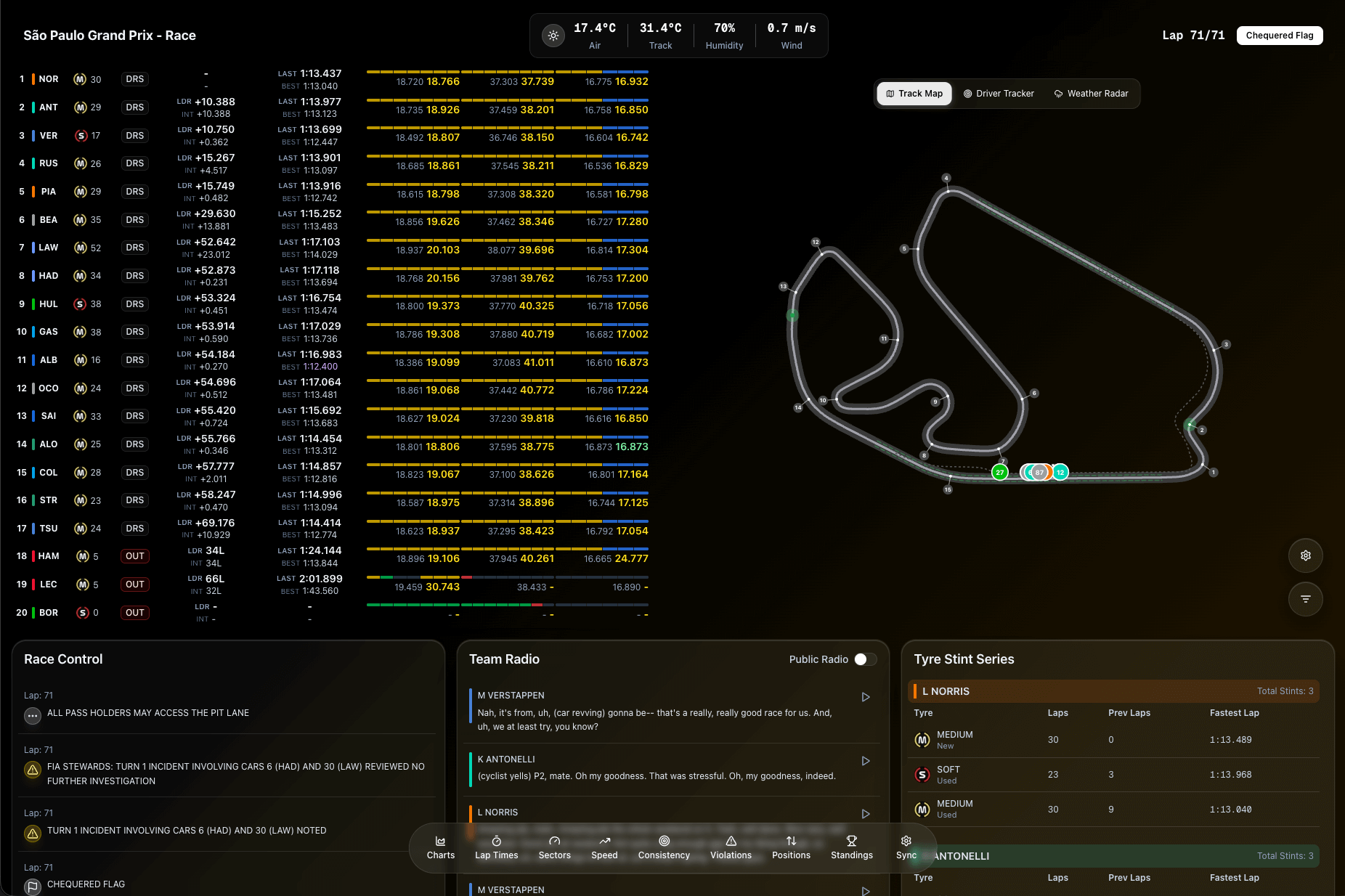
This multi-platform support indicates a professional development cycle, a support team, and a sustainable business model built around a "Pro plan". This model funds the servers, development, and, most importantly, the licensing of data.
Furthermore, Formula Live Pulse offers a developer "API". This is a business-to-business (B2B) level feature that signifies a deep, robust, and reliable data infrastructure. It's a platform designed for serious, heavy-duty use.
F1-Dash: the open-source "hobby project"
F1-Dash, by contrast, is a passion project. The developer states this candidly on the project's website: "f1-dash is a hobby project of mine that I started in 2023".
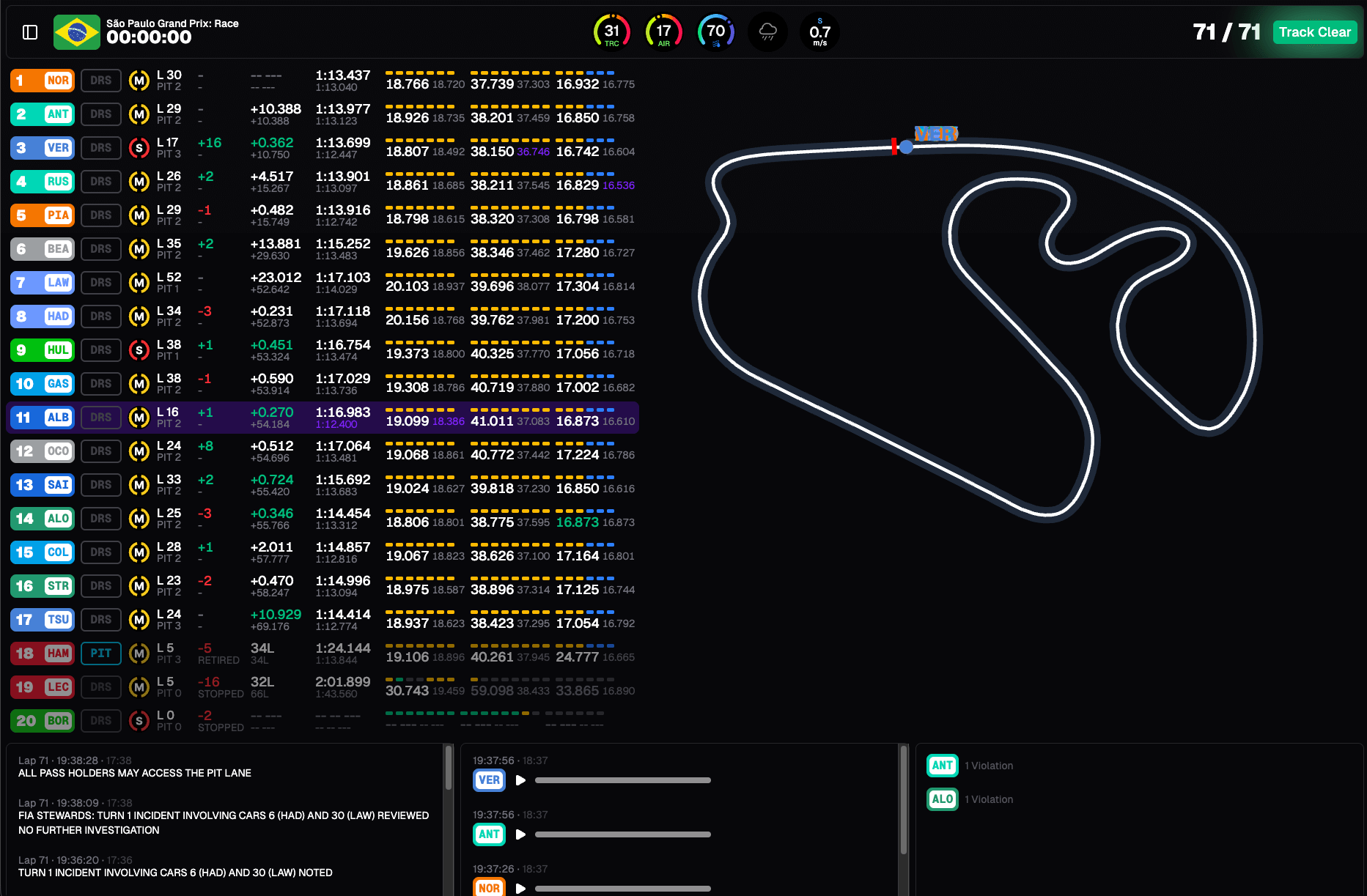
This transparency is commendable, but it comes with critical caveats, which the developer also shares:
-
Project Status: "Currently the project is kind of in a maintenance mode".
-
Codebase: The GitHub repository is "not 100% up-to-date".
-
Developer Focus: The creator is "focusing on other projects".
While F1-Dash is free, its status as a side-project in "maintenance mode" means its long-term viability, bug fixes, and feature development are all uncertain.
The critical weakness: F1-Dash's data "black hole"
The most significant difference---and the central flaw in F1-Dash's platform---is not a missing feature but a "black hole" in its data feed. This issue, which stems directly from its "hobby project" status, invalidates its ability to function as a true telemetry dashboard.
The developer explains the situation directly:
"Formula 1 changed the accesablity [sic] of the positional and car data, as its now locked behind a subscription. As I am not willing to circumvent this... this data is not available anymore".
This one admission is the most important point of this entire comparison. The core "position data & car metrics" are gone.
To compensate, a workaround was implemented:
"For the positional data we now use minisectors to get an approximate position... this is not as accurate as the previous positional data, but it still gives a good indication".

For a data-driven analyst, "approximate" and "not as accurate" are platform-killing words. This single divide is the only thing that matters for serious analysis. A hobby project cannot afford the official, subscription-based data feeds that F1 now requires. A professional product like Formula Live Pulse, funded by its "Pro plan", builds its entire value proposition on having this official, complete, and reliable data stream, as evidenced by its "Live Map" and "Driver Tracker" features.
The debate is therefore not "free vs. paid." It is "incomplete and approximate data" vs. "complete and accurate data."
Feature deep dive: Live Timing & Telemetry (the race day experience)
With the core data-integrity issue established, we can now analyze how this divide impacts the specific features that both platforms claim to offer.
Live Timing (laps, sectors, gaps)
This is the bread-and-butter of any timing app.
- F1-Dash: Its core strength is its user interface, which is "inspired by official Formula 1 graphics". It features an excellent color-coding system for lap and sector times. This is a genuinely well-designed and intuitive UI for at-a-glance information.

- Formula Live Pulse: This platform also provides millisecond-precision timing data, but its power lies in context. The data is not just presented as a static list of times; it is integrated into dynamic charts, such as "lap-by-lap position changes" and "gap to leader" visualizations. It focuses less on just the raw numbers and more on the trends those numbers reveal.
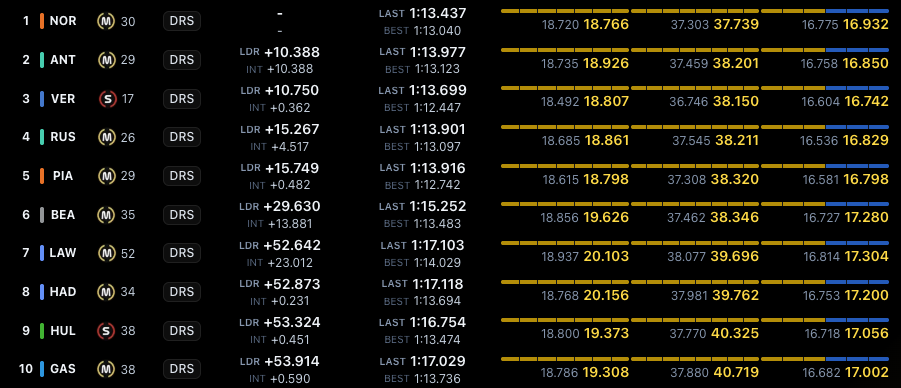
Driver & Track Mapping: the "approximate" vs. the "actual"
This is where the F1-Dash platform's core weakness becomes a catastrophic feature failure.
-
F1-Dash: The site includes a link for a "Track Map". However, this feature is fundamentally broken. As the developer admitted, it does not use actual positional data. It relies on an "approximate position" derived from minisectors. This means you cannot see where drivers are in real-time; you can only see a guess as to where they might be.
-
Formula Live Pulse: This platform offers a "Live Map" and "Driver Tracker," including a unique circular driver tracker that provides a fresh, intuitive visualization of the race. This is a direct parallel to the official F1 TV "Driver Tracker Map" but with unique presentation options. This feature implies that Formula Live Pulse has access to the actual, real-time positional data feed that F1-Dash has lost.
![]()
The loss of this data on F1-Dash has a crippling cascade effect. It's not just that the map is broken. If the positional data is "approximate," then all data derived from it is also unreliable. You cannot truly compare sector times if you don't know exactly where a driver is. You cannot trust live gap data. This flaw reduces F1-Dash from a proactive, real-time analysis tool to a reactive one that can only show you validated times after a lap or sector is already complete.
Feature deep dive: strategic & analytical power
Beyond raw timing, a true "pit wall" tool must help you understand why the race is unfolding the way it is. This is the domain of strategy, analytics, and predictive modeling.
Tyre strategy & Pit stops
-
F1-Dash: It offers basic, but essential, tyre information. The UI shows the current tyre compound (Soft, Medium, Hard, etc.) and the number of laps that driver has completed on them. It is a simple status indicator.
-
Formula Live Pulse: This platform treats tyre strategy as a primary analysis tool, not just a status. It has a dedicated "Tyre Stints" API endpoint and features "comprehensive tyre strategy visualization". It provides post-session telemetry for "Tyre strategy visualisations" and "Stint analysis". It's not just about what tyre is on the car; it's about how that tyre is performing, how it's degrading, and how it compares to competitors. It also has a dedicated "Pit Stops" endpoint to analyze time in the box.

The "pit wall" data stream: What FLP has (and F1-Dash doesn't)
This is a category of features that F1-Dash, as a hobby project, simply cannot provide. These data streams are critical for real-time strategic analysis.
- Live Team Radio & Real-Time Transcription: Formula Live Pulse offers a feature that goes far beyond a simple audio feed. It connects directly to each driver's radio feed and provides real-time transcription of every communication between the driver and the engineer. Crucially, FLP does not wait for F1 to share a team radio clip; the communication is available to users as it happens. This provides an unparalleled, immediate insight into strategy, car issues, and driver feedback that F1-Dash cannot match.
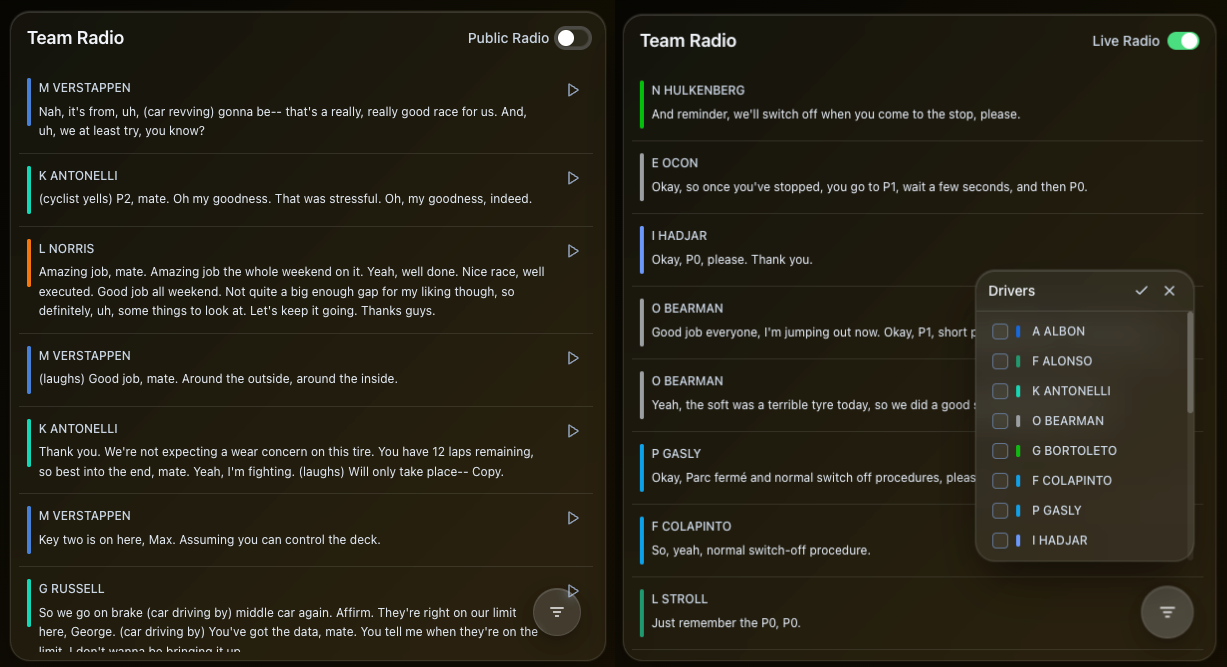
- Official FIA Documents: Exclusive to Formula Live Pulse. This feature provides direct access to official classifications, penalty rulings, and technical documents. It is a professional-level research tool.

Predictive Analysis & Historical Data
-
F1-Dash: It is a purely real-time dashboard. While the developer has mentioned an interest in adding predictive modeling in forum posts, it is not an implemented feature. It does not appear to maintain a historical database for analysis.
-
Formula Live Pulse: This platform is both real-time and analytical. It offers "Historical Session Data Access," allowing users to go back and analyze past races. More importantly, it offers "Championship Prediction" based on live data. This moves it from a simple "timing screen" to a true "analytics suite" that can be used before, during, and after a race weekend.

The decisive X-Factor: AI Analyst vs. Manual Sync
The single most advanced feature from each platform perfectly encapsulates their entire philosophy. This contrast is the ultimate narrative of the "professional product" vs. the "hobby project."
Formula Live Pulse's AI Analyst: your personal race engineer
The "game-changing" feature for Formula Live Pulse is its "personal AI Analyst". This tool directly addresses the "data firehose" problem, where a user is flooded with numbers but starved of answers.
This AI Analyst is an interpretive tool. Its function is to:
-
"Deep dive into all the raw timing data" on your behalf.
-
"Summarizes safety cars, weather shifts, records, and past races in seconds".
-
"Turn gaps, stints, and sector deltas into clear takeaways".
-
Help you "understand pit windows, undercut risks, and tyre trends before they play out".
This feature single-handedly elevates Formula Live Pulse from a data-display tool to an insight-generation platform. It removes the burden of work from the user and delivers actionable intelligence.
The verdict: which F1 dashboard is right for you?
The choice between these two platforms has become remarkably clear. While they may appear to be competitors, they now serve two completely different types of users.
Who is F1-Dash for?
-
The Hobbyist: The tinkerer or developer who is curious about how a dashboard is built and wants to explore a free, open-source (if outdated) project.
-
The Zero-Budget Fan: The user on a strict zero-dollar budget who wants a simple, color-coded leaderboard for lap times and is willing to accept a project in "maintenance mode".
-
The Non-Critical User: The fan who is willing to accept "approximate" positional data and does not mind the lack of strategic data (Race Control, FIA docs) or the manual work of a "Delay Control".
Who is Formula Live Pulse for?
-
The Serious F1 Enthusiast: The fan who demands complete and accurate data, including real-time, official positional tracking.
-
The Data-Driven Analyst: The user who wants to go deep on "Head-to-Head" matchups, "Tyre Stint" analysis, and "Historical Data".
-
The Fantasy Manager: The player who needs to understand "Championship Predictions", pit windows, and "undercut risks" to win their league.
-
The Modern Fan: The user who is overwhelmed by raw data and sees the immense value in an "AI Analyst" that delivers clear, actionable insights.
-
The Developer: The creator who needs a reliable, professionally supported "API" to build their own applications.
The final recommendation
While F1-Dash was a commendable and important open-source project, its time has passed. By the developer's own public admission, it is a "maintenance mode" project with a permanent, unfixable data gap at its very core.
A real-time data dashboard that cannot show you where the cars are with certainty is fundamentally flawed.
Formula Live Pulse is the clear successor, representing the next generation of F1 fan tools. It is a professionally supported, actively developed platform that provides a complete, accurate, and insightful data ecosystem. For any fan seeking a true pit-wall experience in the modern F1 era, Formula Live Pulse is the clear and definitive choice.
